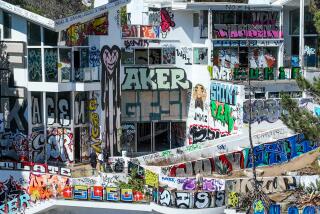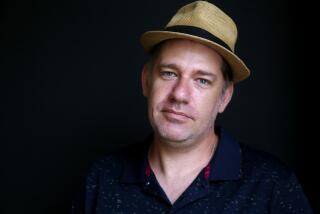Global’s Unsinkable Captain
Even by the standards of Bel-Air, Gary Winnick’s mansion on Bellagio Road is lavish.
Perched on a bluff overlooking the Bel-Air Country Club, the Georgian-style house commands views from downtown to the coast. Its 64 rooms include a kitchen with six sinks and enough ovens to warm 100 plates at once. The master suite boasts separate massage, sitting and shower rooms. There are a dozen bedrooms and a dozen bathrooms just for servants.
But Winnick isn’t satisfied. He’s spending millions to restore the 65-year-old estate.
Inside, craftsmen are stripping away seven layers of paint, refurbishing antique doorknobs and light fixtures and sculpting plaster crown moldings using techniques in vogue when the house was built. Outside, as many as 100 workers are resurfacing patios and replacing ailing trees and shrubs.
None of this sits well with former employees and shareholders of Global Crossing Ltd., the telecommunications company Winnick founded in 1997. For a few years its stock soared on hope and hype. Then, in January, the company filed the fourth-largest bankruptcy case in U.S. history, wiping out $54 billion of shareholders’ money and putting thousands of employees out of work.
Winnick, the company’s chairman and the largest individual shareholder, lost billions in paper wealth. But he had sold millions of shares two years earlier, when the stock still was flying high. He cleared more than $575 million then and used some of it to buy his $94-million mansion--the highest price ever recorded for a home in Los Angeles County.
Now the 8.4-acre spread has become the stuff of legend among those who lost their jobs, investments or both in Global Crossing’s collapse. They see the 23,000-square-foot mansion as symbolic of the excesses of the tech boom, when stock options and a giddy atmosphere on Wall Street enabled some entrepreneurs to get rich even as the firms they led were about to melt down.
“The company’s going down the tubes, and he’s flaunting his money and spending millions of dollars on the house,” said former Global Crossing employee Michael Nighan, who has joined other laid-off workers in an effort to recoup $32 million in severance pay wiped out by the bankruptcy filing. “At this point, we’re beyond anger. Now it’s amazement more than anything else.”
The house and the elaborate renovation are lampooned regularly on a Web site run by former Global Crossing employees. “Where do I sign up as a subcontractor? I need a job,” one former worker wrote recently.
Other tech leaders have been humbled by the collapse of their companies. In April, Bernard J. Ebbers, the deposed chief executive of long-distance giant WorldCom Inc., sold his yacht to pay off some of the approximately $400 million he owes on loans he used to buy now-worthless company stock.
Enron Corp.’s former chairman, Kenneth L. Lay, sold luxury homes in Colorado and Texas to stave off personal bankruptcy. His wife, Linda, opened a thrift store in hopes of raising cash by selling family castoffs.
Winnick, by contrast, continues to pour money into his home renovation, which is expected to cost as much as $30 million. Because the house is Winnick’s personal property, it cannot be seized by Global Crossing’s corporate creditors as part of the bankruptcy.
“People talk about the house all the time,” said attorney Randy Sunshine, a golf enthusiast and member of the Bel-Air Country Club who has watched the renovation from the five greens that surround the house. “You can’t help it--it’s just so huge and it just looms right over the golf course. And with all of what’s going down with Global Crossing, I think there’s an irony there.”
Built to Be Talked About
The mansion--dubbed Casa Encantada, or House of Enchantment--was built to be talked about. Its very design reflected the original owner’s determination to impress.
A gurgling fountain adorned with bronze statues dominates the long, curving driveway, and four slender columns frame the entrance beneath a triangular pediment. Painted the color of white stone and topped with a pitched copper roof, the mansion would look at home on the Mall in Washington.
Inside, a grand, curving staircase rises above the entryway’s parquet floor. Each step is decorated with an oval design resembling a seashell. The grounds--big enough to hold three major league baseball fields--include several lawns and plazas, elaborate formal gardens, a tennis court, a pool, a two-story pool house and a pair of greenhouses. Pine, eucalyptus and other trees shield the estate from public view.
Winnick, who lives in a Brentwood estate, declined to discuss his Bel-Air house. Friends say the 54-year-old entrepreneur, who has pledged more than $100 million to charity over the years, considers the restoration another of his many philanthropic efforts.
Previous owners opened the house for lavish parties and fund-raisers to benefit a variety of causes.
“It’s a very handsome house,” said actress Jane Wyatt Ward, who lives nearby and visited the house when hotel magnate Conrad Hilton was the proprietor.
“The dining room was huge, about three times as big as mine,” said Ward, best known for her role in the 1950s TV series “Father Knows Best.” “The living room and the library are immense. It has very high ceilings. And there were formal gardens. I hope when [Winnick] gets through he has an open house so we can all see the beautiful gardens.”
The house was built for Hilda Olsen Boldt Weber, who purchased the property in 1934 for $100,000. A New York City nurse who married one of her wealthy patients, Weber wanted to build an estate that would give the impression of old money, according to books on the history of Bel-Air.
She hired architect James Dolena, who prepared 400 sets of plans before Weber was satisfied with the design. The house took two years to build and cost an estimated $2 million--$23.7 million in today’s dollars--including elegant sculptures and paintings and room upon room of custom furniture, designed specifically for the estate.
Poor investments and gambling cost Weber her fortune, and she had to sell. Hilton bought the house and its contents in 1950 for a mere $225,000.
Hilton made few changes during his 19-year stay. He kept the furniture, the aging French lace curtains and the somber green paint, but converted a playroom into a trophy room. Though he was in his 70s when he moved into the mansion, Hilton hosted frequent parties, sometimes rolling up the carpet for dancing. The house served as a backdrop for several movies, featuring stars such as Natalie Wood, Robert Redford and Christopher Plummer.
After Hilton’s death in 1979, Dole Food Co. Chief Executive David Murdock purchased the property for $12.4 million and sold most of the original furnishings and art. In the 20 years he owned Casa Encantada, Murdock held numerous political fund-raisers there and hosted Presidents Richard Nixon, Ronald Reagan and George H.W. Bush.
Winnick, himself a major fund-raiser, visited many times while Murdock owned the house and tried to buy it.
“He fell in love with the house,” said Rosalie Zalis, a longtime friend and executive director of the Winnick Family Foundation, the vehicle for Winnick’s charitable giving. “It’s just a beautiful property.”
Murdock rebuffed several offers from Winnick before finally succumbing, said Jeff Hyland, co-author of “The Estates of Beverly Hills” and president of Hilton & Hyland Real Estate in Beverly Hills.
“He didn’t want to sell, but Gary kept sweetening the pot,” Hyland said. “David finally said, ‘I’ve got to do this. I’d be foolish if I didn’t.’ ”
Winnick grew up far from Bel-Air, in the Long Island town of Roslyn. His father owned a food service business that fell into bankruptcy in 1960. While attending the C.W. Post campus of Long Island University, Winnick worked as a bus driver, a golf caddy and a ski-shop salesman. After college, he signed on with a furniture retailer that failed.
Then Winnick joined junk bond king Michael Milken at Drexel Burnham Lambert, moving to Los Angeles in 1978 to work in the bond sales operation. The division became the centerpiece of a fraud scandal, though Winnick never was charged with wrongdoing. He left Drexel in 1985 to start his own investment firm.
He became a man of influence in Los Angeles, donating heavily to political causes, funding a children’s petting zoo and pledging $40 million to the Simon Wiesenthal Center to help pay for an institute on peace and tolerance in Jerusalem.
In 1996, he launched what became Global Crossing. The firm was built on a vision of wiring the world with fiber-optic cable to transmit phone calls, faxes and e-mails.
Winnick had little expertise in telecommunications, but he knew how to sell. He raised $20 billion from investors, more than any corporate start-up ever. Over the next four years, the company laid more than 100,000 miles of cable across continents and beneath oceans.
Though the firm never turned a profit, expectations that customers would rush to use the network sent its stock soaring. Winnick was crowned the richest person in Los Angeles in a 1999 ranking by the Los Angeles Business Journal. His stake in Global Crossing then was worth $6 billion.
But the network did not fill with traffic. Demand was much lower than expected, and other start-ups competed for customers. Global Crossing couldn’t bring in enough revenue to repay its debt. A lack of stable leadership made matters worse: The company changed CEOs five times in four years.
Global Crossing’s accounting methods came under scrutiny early this year. After the bankruptcy filing, the Securities and Exchange Commission launched an investigation. Angry investors have filed dozens of lawsuits against the firm.
Fixated on the Details
Before the money ran out, Winnick was known for his free spending and his love of historic architecture.
As chairman, he lavished perks on Global Crossing executives and board members, including Aston Martins and Rolls-Royces. Among his pet projects was a meticulous $7.5-million restoration of the ornate former MCA building in Beverly Hills, where the company’s executive offices were based.
Former employees say that even the smallest details of the renovation commanded Winnick’s attention. He personally inspected each brick and ordered replacements for those that were dirty, the wrong color or just not right. He repeatedly rejected the shades of white paint used in the hallway leading to the room he chose as his office, a replica of the Oval Office.
“They went through painting the whole area five times or so to get it just exactly the shade he wanted to complement his art,” said a former Global Crossing manager.
Though it drove his subordinates to distraction, Winnick’s perfectionism earned him great respect among preservationists, who are grateful to see Casa Encantada in the entrepreneur’s hands.
“We don’t have any historical protections here, so it’s always a sigh of relief when someone buys an important house and does the right things to it,” said Hyland, who also is an architectural historian.
Although close friends say Winnick is a modest man not prone to self-aggrandizement, he often surrounds himself with politicians and notables. Most of his charitable donations have put the Winnick name on buildings, scholarships or other projects.
His latest acquisition “is a definite trophy property,” said Joyce Rey, executive director of Coldwell Banker Previews International in Beverly Hills, the estates division of the realty firm. “It takes a certain personality to want it.”
More to Read
Inside the business of entertainment
The Wide Shot brings you news, analysis and insights on everything from streaming wars to production — and what it all means for the future.
You may occasionally receive promotional content from the Los Angeles Times.











